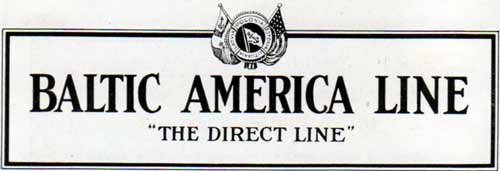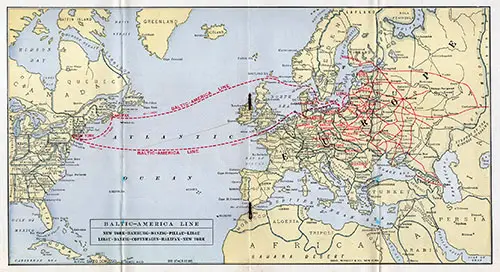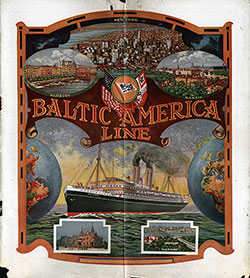Baltic America Line Archival Collection

The Baltic America Line offered passenger steamship service between the ports of New York, Hamburg, Danzig, Libau and Halifax with a fleet of four ocean liners. The fleet consisted of the steamers Latvia, Polonia, Lituania, and Estonia.
They offered intermediate class accommodations for First Class, Cabin, Tourist and Third Class passengers. They were in operation for less than a decade during the 1920s. In 1930 the Baltic America Line was taken over by the Polish Transatlantic Shipping Company (Gdynia-Amerika Linje).

Route Map of the Baltic America Line (1920s). Baltic America Line Fllet and Services, 1920s. | GGA Image ID # 21fd9cac03. Click to View a Larger Image.
The Baltic America Line was formed out of the former Russian East Asiatic Company's liners Czaar, Czaritza and Kursk which were renamed the Estonia, Lituania, and Polonia and operated under the Danish Flag. They provided service between Libau, Danzig and New York. They are often referred to as the Baltic America Line.
Baltic America Line Ephemera

1920s Brochure - Baltic America Line Fleet and Services
The American Tourist seeking rest, recreation, study or new business connections in Europe can therefore not find a more opportune time to go than during next summer, using all the exceptional facilities offered by the "Baltic America Line"
Latvian Government Facilitates Emigration from Russia
Liban (J. T. A) The Latvian Government has granted a special license
to the Baltic America Line, in accordance with which all Latvian consuls located throughout Russia and Ukraine are authorized to grant to passengers holding Baltic America Line prepaid tickets a Transit Visa, which enables the passengers to proceed to Riga, where they can remain for a period of three months in order to complete their arrangements with the American Consul for an American visa.
Until this license was granted to the Baltic America Line it was very difficult for a passenger from Russia to go through Latvia in order to apply to the American Consul for a visa, but now this problem, which has been the greatest obstacle in the path of Russian passengers, has been solved.
The number of passengers from Russia going on the steamers of the Baltic America Line, direct from Liban, are increasing with the departure of each ship, and with the settling of this vexatious problem, the emigration from Russia will no doubt increase a great deal, more especially since the Russian quota is still open for 20,000 passengers.[1]
[1] "Cable and Telegraphic News," The Reform Advocate, 9 September 1922, Page 129
Recap and Summary of the Baltic America Line Archival Collection
The Baltic America Line (1920s) was a short-lived yet significant transatlantic steamship company that provided passenger services between New York, Hamburg, Danzig (Gdańsk), Libau (Liepāja), and Halifax. It primarily catered to First-Class, Cabin, Tourist, and Third-Class passengers, offering intermediate accommodations at a time when immigration and tourism between Europe and North America were at a peak. The line was absorbed into the Polish Transatlantic Shipping Company (Gdynia-Amerika Linje) in 1930, marking its brief but impactful role in ocean travel history.
This archival collection serves as an invaluable resource for teachers, students, historians, genealogists, and maritime enthusiasts, shedding light on migration patterns, European travel, and the transatlantic shipping industry of the early 20th century. The collection features route maps, brochures, advertisements, and historical reports that provide rich insights into passenger experiences, geopolitical factors influencing travel, and the role of the Baltic America Line in facilitating emigration from Russia and Eastern Europe.
Why This Collection is Important for Different Audiences
1. For Teachers & Students (History, Immigration, and Maritime Studies):
- Explores transatlantic migration trends of the 1920s, especially for Eastern Europeans emigrating to the U.S. and Canada.
- Provides insights into how steamship companies shaped immigration policies and travel logistics.
- Maps and brochures illustrate the major port connections between New York, Hamburg, and Eastern European cities.
- Useful for lessons on economic migration, visas, and travel barriers for emigrants from Russia and Ukraine.
2. For Genealogists & Family Historians:
- Offers historical documentation of passenger movements, especially for those with ancestors from the Baltic States, Poland, Russia, and Ukraine.
- The 1922 Latvian government’s transit visa policy helped Russian emigrants secure American visas, making it a crucial moment for family migration histories.
- Prepaid Baltic America Line tickets enabled emigrants to travel through Latvia, solving a significant bureaucratic barrier for Russian emigrants.
3. For Historians & Maritime Enthusiasts:
- Documents a little-known but influential shipping company that played a role in transatlantic migration and trade.
- Highlights the transition from Russian-controlled steamship operations to Danish and then Polish ownership, reflecting geopolitical changes post-WWI.
- Includes fleet details and the renaming of former Russian East Asiatic Company liners, providing ship historians with valuable reference materials.
4. For Immigration and Social Policy Scholars:
- The Latvian government’s role in facilitating emigration from Russia shows how visa regulations and transit policies impacted migration.
- Documents the role of shipping lines in assisting emigrants with legal and logistical challenges, showcasing the relationship between private companies and government immigration policies.
- Highlights Eastern European migration trends during a time of shifting U.S. immigration quotas.
Key Highlights from the Collection
1. A Direct Link for Eastern European Migrants (1922 Latvian Visa Policy)
- The Latvian government granted a special license to the Baltic America Line, allowing Latvian consuls in Russia and Ukraine to issue transit visas.
- This made it easier for Russian emigrants to travel through Latvia and obtain U.S. visas, solving a major bureaucratic hurdle.
- As a result, emigration from Russia increased significantly, with thousands using Baltic America Line ships.
2. The Baltic America Line’s Fleet & Transatlantic Routes
- The fleet consisted of four steamships:
- Latvia
- Polonia
- Lituania
- Estonia
- These ships were former Russian East Asiatic Company liners (Czaar, Czaritza, Kursk), which were later renamed and operated under the Danish flag before transitioning to Polish ownership.
- The company provided direct service between Libau, Danzig, and New York, catering to both intermediate-class tourists and third-class emigrants.
3. The Role of the Baltic America Line in Migration & Tourism
- The company positioned itself as a premier choice for American tourists traveling to Europe, as seen in its 1920s promotional brochures.
- It also played a crucial role in migration, particularly for Eastern European and Russian emigrants seeking better opportunities in North America.
- The company's strategic ports—New York, Hamburg, Danzig, Libau, and Halifax—were key transit points for European migration.
Most Interesting and Unique Content
1. 1922 Latvian Visa Agreement – A Turning Point for Russian Emigrants
- This government agreement gave Baltic America Line passengers from Russia and Ukraine special transit privileges, helping them reach the U.S. and Canada.
- The article from The Reform Advocate (1922) states that the Russian quota was still open for 20,000 emigrants, making this a critical moment in migration history.
2. 1920s Baltic America Line Route Map
- This historical map illustrates the company’s key port connections across the Atlantic, providing valuable context for migration routes and shipping logistics.
3. 1920s Baltic America Line Brochure
- Advertises tourist and emigrant travel opportunities, reflecting the marketing strategies of steamship companies at the time.
- Highlights the luxury of First-Class and Cabin-Class accommodations, while also catering to affordable Third-Class travel for emigrants.
Conclusion: A Crucial Archive for Migration & Maritime History
The Baltic America Line Archival Collection offers rare insights into transatlantic migration, steamship travel, and European-American relations during the 1920s. This collection is particularly valuable for teachers, historians, genealogists, and maritime researchers seeking to understand how shipping companies facilitated migration and international tourism.
From government visa agreements that enabled Russian emigrants to travel more freely to brochures advertising luxury and economy-class travel, this archive paints a vivid picture of life at sea, global migration trends, and the evolution of ocean travel in the early 20th century.
Whether you’re researching family migration routes, exploring early steamship tourism, or studying the impact of government policies on immigration, the Baltic America Line collection is a must-see resource for understanding this fascinating era of transatlantic history.
